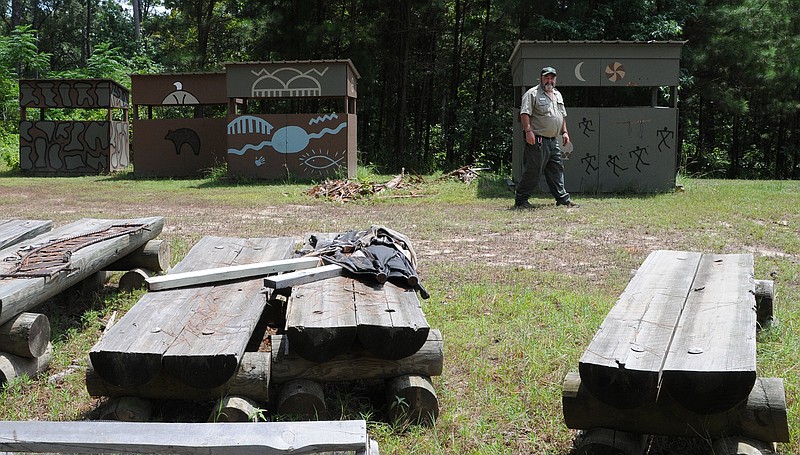If deer could read, they surely would like Roger Moulton's deer stands out at Atlanta State Park.
The stands are painted in such a way to tell a story. They have American Indian sign language all over them.
Moulton, the park's interpretive ranger, says Indians of today or yesterday would be able read the deer stands. The signs are authentic, he said.
Moulton has built 10 of the stands and placed them out along the pathways for hikers in the park. It's a new idea. In the past, and before the recent lake flooding that washed many of the stands away, they might have been placed off in the woods."The idea is that these deer stands can now help the traveler stay dry and comfortable as they hike the park and then find a place to sit and view the animals and birds," Moulton tells.
Moulton said he wanted to be creative and paint the stands "kinda cool. Sometimes the deer in our park will come close to you."
There are only two times in the year when the deer can be hunted. One adult hunt will be Nov. 15 to 17 , and a youth hunt will be held early in January. The rest of the time, animals and birds are to be seen and appreciated.
"We keep everything alive in the park," Moulton said. "We allow everything to live naturally as they are because one living thing is as important as anything else. If you remove whole species, it will show up."
The sign language on one of the stands tells of the recent flooding in the park. Bolts of lightning at the top strike clouds underneath. Then the sign language shows water pouring into streams and enlarging the lake shown as a circle. Then, the story concludes with the sign of abundant fish.
Such sign language for Indians goes back thousands of years, Moulton said.
"One day I'll be retired and gone, and people will come in a see this deer stand panel and know of a great flood that happened here if they, too, can read the signs."
Here are some other Indian symbols and their meaning.
- The stick figures of little people are dancers, maybe with a drum or flute nearby. So, of course, these are happy and peaceful Indians.
- The broken arrow is another sign of peace.
- The flashing lines above the head of an individual indicates high intelligence here. The symbol of the bison's horns indicate a medicine man or shaman is nearby.
- One swirling circle indicates the four ages of men as well as sun, moon and stars.
- The symbols of the bear and eagle are for power and honor. For the eagle especially, also wisdom.
- Any lightning symbol stands for change, renewal and fertility.
"Any time we begin to know sign language, we begin to understand," Moulton said. "That's what makes a trip to the park better. For this was a Caddo Indian village. They were here first, and it's our role to educate ourselves and not disturb, but appreciate."
Moulton recently spent time educating himself. He went to Austin's state archeological laboratory where artifacts are kept.
"I wanted to see and know about what has come out of Atlanta State Park. Shards, flints, arrowheads, grinding stones and such things as these. Some of the best stuff such as pottery is kept at the University of Texas. That's what I really want to go down and see."
Moulton said when something is found at the park it, can be bagged, sealed and labeled. But often it is left exactly where found. Then, an archaeological steward can be called who will come and remove the item properly. Thereafter, GPS can be used to locate the find precisely.
Moulton said that in 1952, before Wright Patman Lake filled the area, a gravesite was discovered with remains of about 10 people.
"It seemed to be, perhaps, two families. They and what was found inside the grave with them were described, such as favorite pottery or stones. Things that might be needed in the next life."
The task, he said, is to take one's time, see where and how things are placed. All this gets documented and sent to University of Texas to be placed in a controlled environment and kept forever. Anyone can go by who has an appointment, pull these things out and look at them.
"That's what I want to do," he said. 'Then, I can come back, and we'll have interpretive programs for the visitors to our park."

